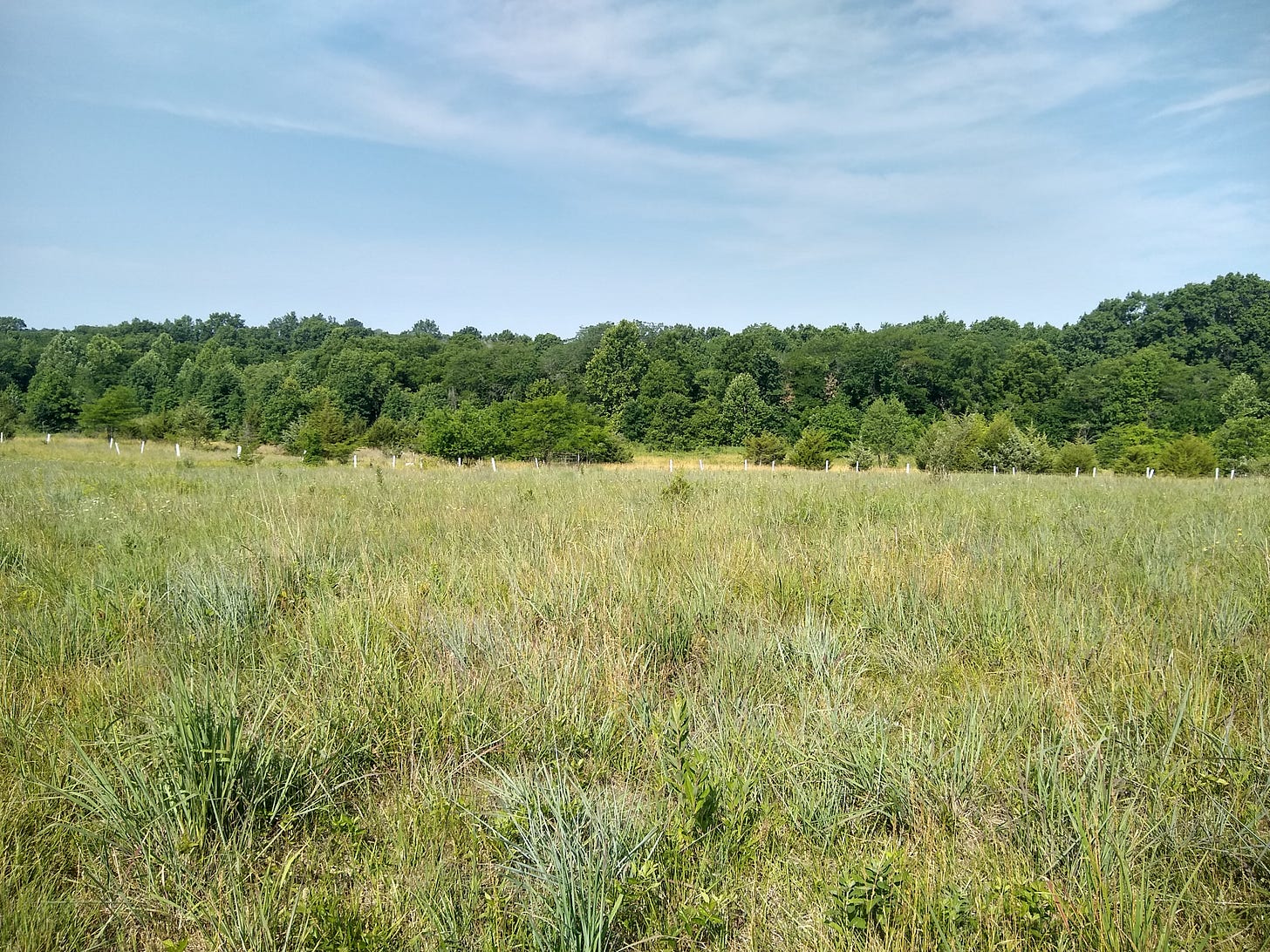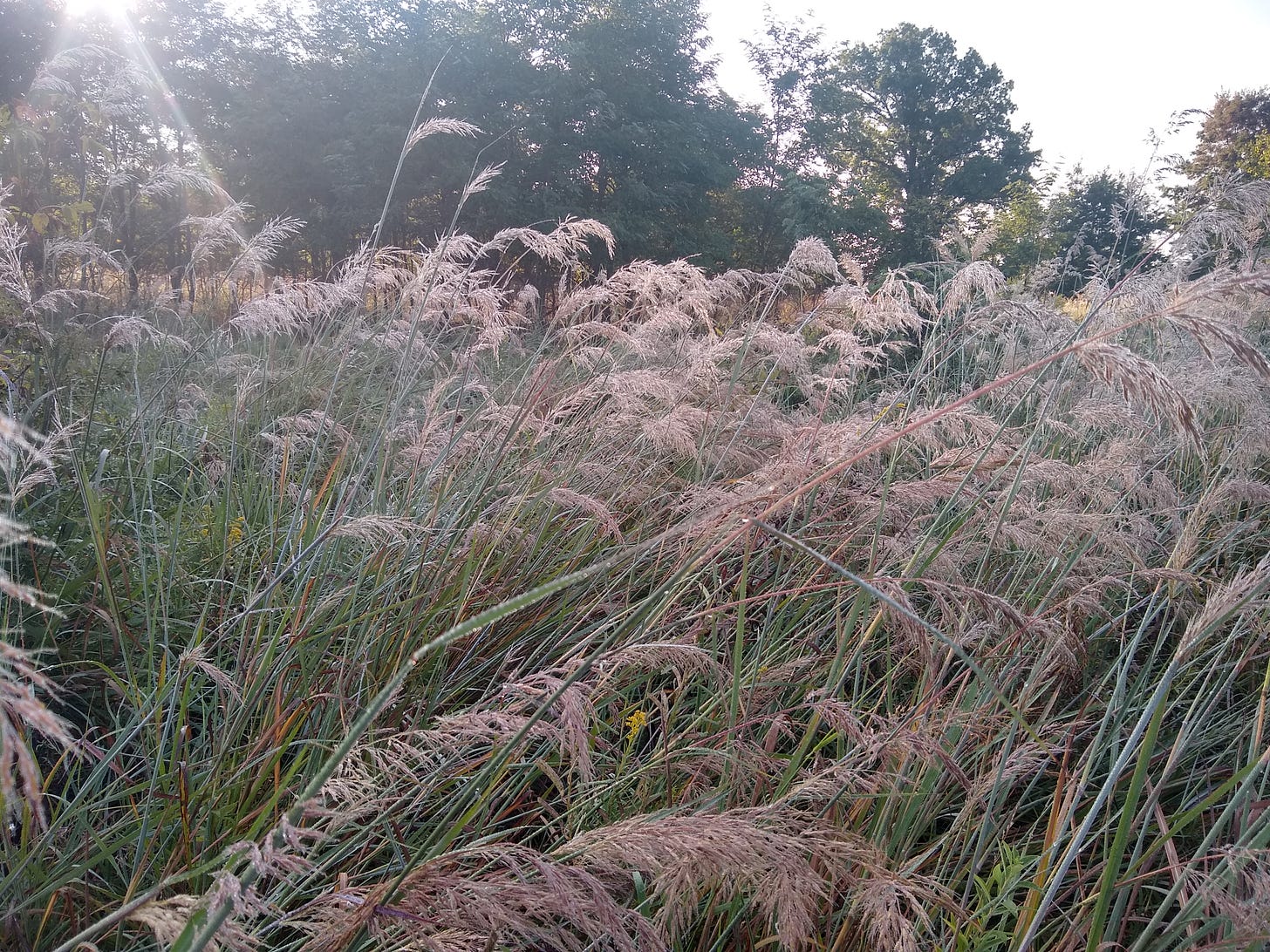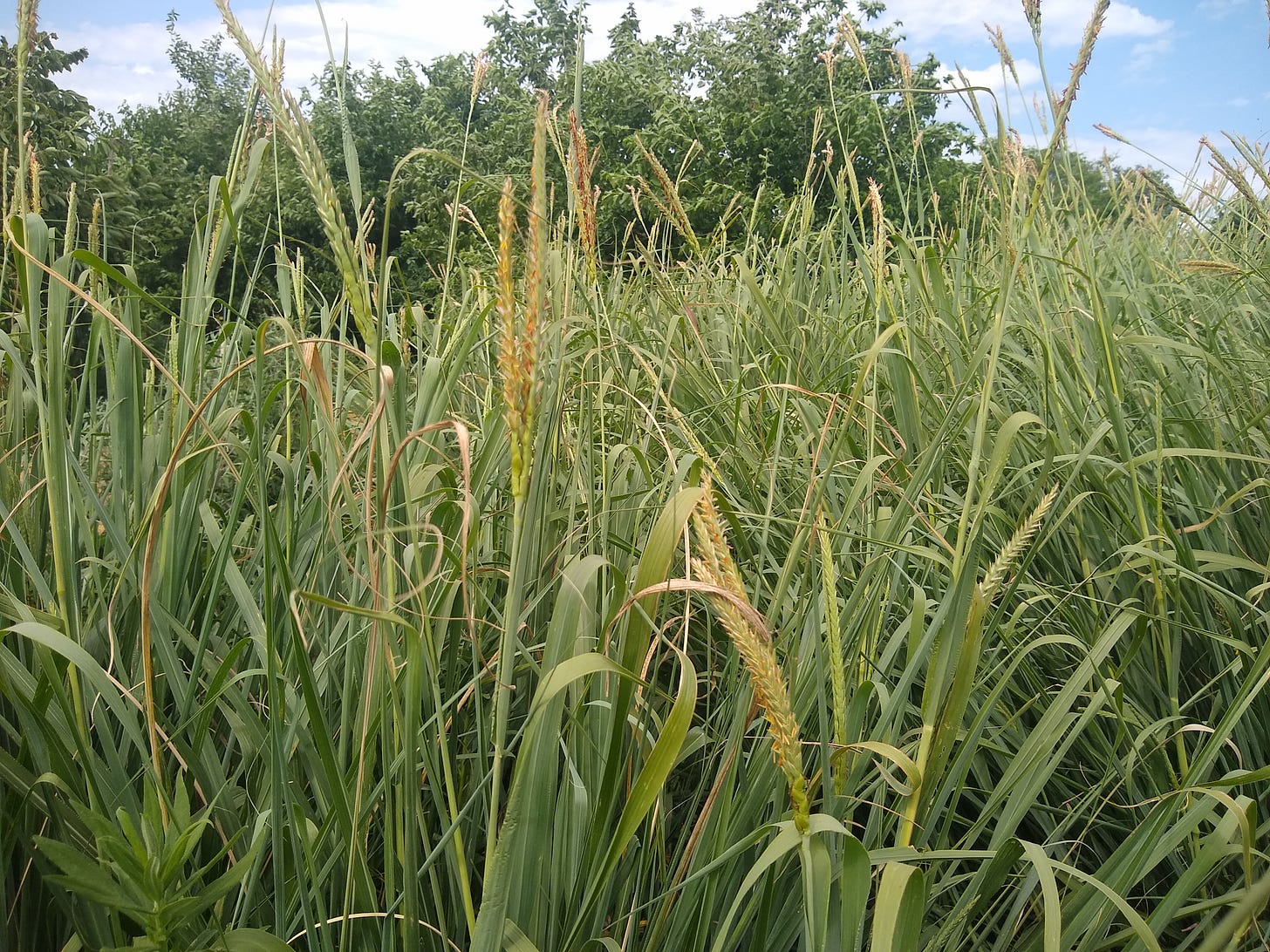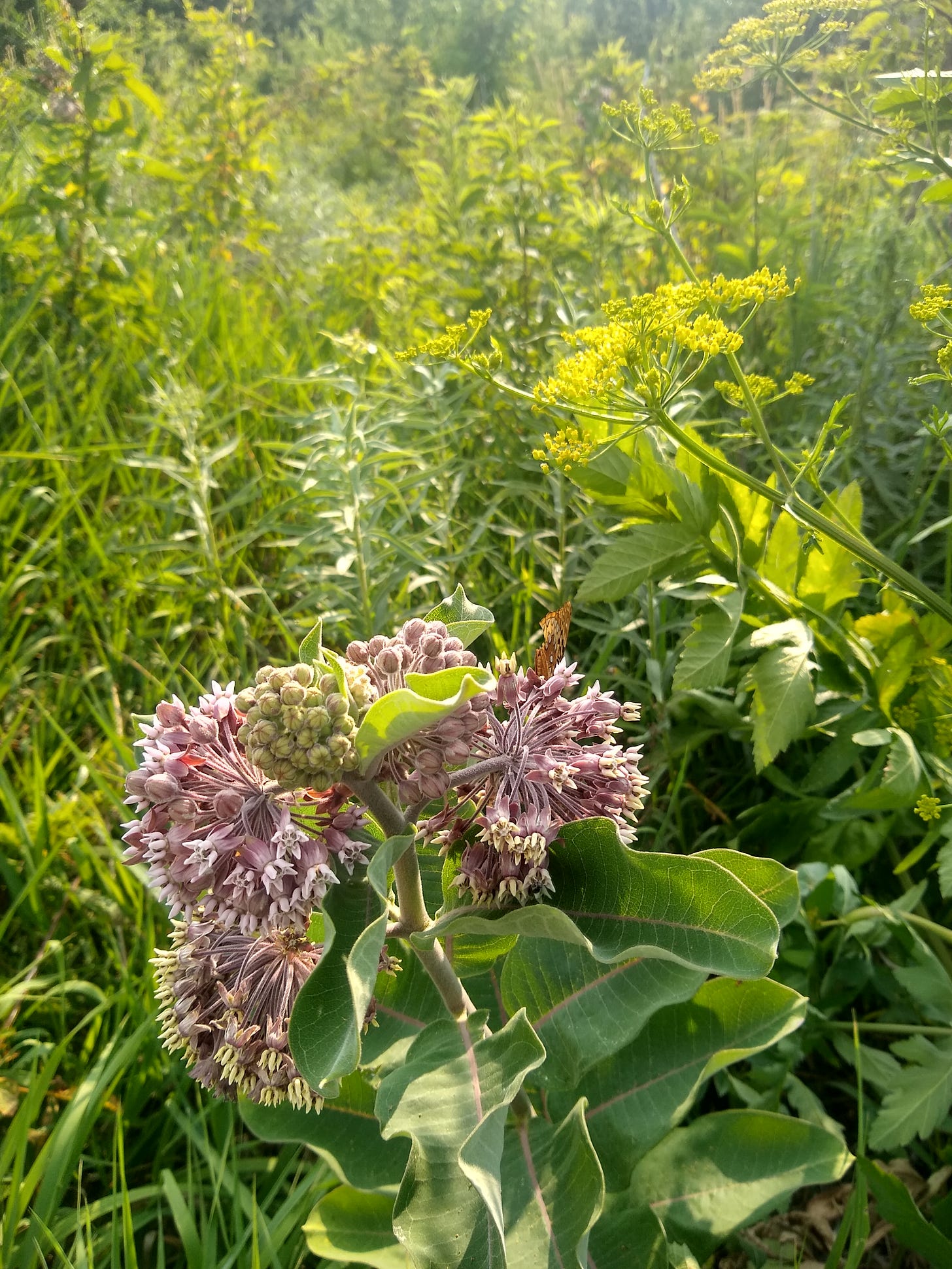Grasses that are Saving our Asses
The oasis in our agricultural wasteland may just be the plants that have grown right here the past 10,000 years
A persistent and forceful wind presses against the desiccated and curled leaves of hedge and elm up here on our stretch of old fenceline. From down yonder, amidst the peeping call of turkey poults, the shrill chortle of house sparrows, and cicadas making their brief debut in the soundscape, two fields stand, lashed by the constant gusting of dry air. One is composed of typical, Eurasian-type cool season grasses, the remnant stalks of a pasture crop gone dry and dormant, flitting stiffly in the gale, brittle seed-heads softly rattling like loose bones. The other, fatter, denser, and greener, is composed of native warm-season prairie grasses. It sways and slaps its fat leaves in the onslaught of dry wind, unperturbed, happy to thrive in what little moisture has been provided this season. This second grass is what the kids call “dummy thick.” Right kids?
Both of these fields were grazed at nearly the same time: the brown and brittle, nearly dormant field is made up of commonly promoted “agronomic” plants like fescue, bluegrass, and clover, while the other is dominated by deep-rooted native grasses more at home in a conservation plot than a production forage planting. They have the same poor quality soil, a similar aspect along the slope, and have been managed in an identical manner. What makes these two fields so different from each other? The Hatch-Slack pathway. Understanding the inherent potential of boring y’all to death, and the negative effect that would have on my Substack stats, let’s table our discussion of carbon fixation, photorespiration, and metabolic exchange for a couple more paragraphs.
In a year when “exceptional” drought is creating major disturbances throughout the Midwest, Sorghastrum nutans is the grass that’s saving our ass. Now I’m not using binomial nomenclature to impress y’all, as likely, you are impressed already; I’m using it because the common name for this grass is, well, a bit unfortunate. The common name in current use is Indiangrass, which brings a complicated dynamic to talking about this very awesome plant. Also unfortunate, Sorghastrum nutans doesn’t quite roll off the tongue, so I may as well start a campaign for a new common name for the grass in question. I’m not exactly sure how to do that, but I’m going to try. I think a name that pays homage to some of its traditional, indigenous use but doesn’t use an outdated or overly generalized term regarding the culture it is a part of may be a good start, so for the rest of this publication, I will refer to sorghastrum nutans as basketgrass. If any readers out there know of or can suggest a new (or old) alternative name, I’m interested to hear what you think. There is some movement within the scientific community to move away from nomenclature that is potentially offensive, inaccurate, or otherwise problematic, so I’m following suit for the next few hundred words, going forward with the full knowledge that I am not in charge of names.
Sorghastrum nutans in flower
Anyhow, “basketgrass” is native to the central tallgrass prairie ecoregion. That’s us! It co-evolved with bison grazing and fire. It’s tough. It gets tall, real tall, well above my head at flowering, with equally deep roots that reach down and tap water and nutrients unavailable to all those agronomical, Eurasian type grasses. As a bunchgrass, it doesn’t form sod so much as dummy thick, dense clumps. It gets a slow start in the season, being impractical to graze until the summertime, just as those cool-season grasses are giving up the ghost. Our cows find it palatable from that time until it goes to seed, at which point the turkeys seem to find the seed heads almost as tasty as grasshoppers, with fewer calories expended in their pursuit. Sorghastrum nutans doesn’t merely tolerate fire, it thrives under a burn regimen. It can be overgrazed, especially when young, early in the season, but can provide a couple rotations every year so long as they occur once it reaches over a foot in height. Come dormancy, the thatch is thick and luxurious, making coarse mulch or bedding for high traffic loafing yards, and as it turns out, baskets. I like to scythe down some of the thatch in late winter and lay it out to armor fragile soils and build organic matter during the wettest parts of early spring.
Yet another grass we’ve been working alongside of is Eastern Gamagrass (Tripsacum dactyloides), another warm-season bunchgrass native to the eastern part of North America. We have planted a commercial cultivar, known as ‘Pete’. Gamagrass is a relative of corn, and even produces a large, energy-rich seed. Unlike corn, the seed is extremely hard, to the point of being undesirable feed, at least in my efforts to harvest and throw it out to poultry, or nearly bust my molars trying it out for myself. What Eastern Gamagrass does have going for it is early growth for a warm-season grass, rivaling the springtime availability of our non-native types, and a unique morphology that provides deep shade and shelter below where poultry can rest in cool dirt or evade aerial predators. These two drought tolerant grasses, along with Big Bluestem, Little Bluestem, Switchgrass and others, can provide a water efficient, heat tolerant alternative to cool-season Eurasian grasses that encourage wildlife and biodiversity all while keeping your cows fat in a rough year like this.
Eastern Gamagrass is already six feet high and in flower now in late June
Native warm season grasses like these all have one thing in common, and that is C4 carbon fixation, AKA the Hatch-Slack Pathway. If all this grass talk is getting you excited as it is, you’re going to love how I break it down next. Y’all remember photosynthesis, right? Where plants combine sunlight, water, and carbon dioxide to generate carbon for their own survival, and oxygen for the atmosphere, right? Well, C4 plants go to 11, and on a much tighter water budget. The more common carbon fixation pathway for grasses is the C3 pathway, which seems to have evolved under the canopy of trees, whereas C4 grasses became prominent in the evolutionary landscape during the Oligocene, when open, treeless areas became more prevalent on the earth. C4 grasses transpire less moisture in the photosynthesis process, and utilize carbon molecules differently, ultimately sequestering a much larger amount of the stuff. How much? According to a 2005 study in The New Phytologist, C4 plants represent around 5% of the earth’s plant biomass, but account for 23% of terrestrial carbon sequestration. In other words, C4 plants are pulling more than their weight, in our own farmstead system and on a global scale.
C4 plants include more than just our native warm-season grasses here in the prairie biome of North America. Millet, sugar cane, sorghum, corn, and even some salt-tolerant relatives of lambsquarters exhibit the Hatch-Slack Pathway, making these crops highly valuable beyond their economic and caloric properties. C4 plants also thrive in low nitrogen conditions, making them a boon in this era of “Peak Fertilizer.” (If only there were some other form of fertility that we’re all actively producing that is a major environmental liability in the way it is commonly handled and processed that could be utilized instead of wasted...)
Corn is perhaps our most widely planted C4 plant in North America. Much like our native prairie grasses, it isn’t ready to emerge until late and puts on a prodigious amount of growth in a short time.
Tall grass pastures can host more than C4 grasses and livestock; native forbs, vital insects, and keystone fauna all make up parts of the whole.
Under the dense cover of Eastern Gamagrass, our turkeys spend the hot days in shade and safety.
It is another smokey, hazy day here in the parched Heartland. Along the fields, underneath a sulfuric cloud of Canadian brimstone (19.2 million acres burnt as of today), soybeans barely reach up to the gunpowder air, shriveled and stunted. Fly-bit herds of cattle graze Eurasian grass to the nibs. The terminal ends of tree growth have died back in some places, and even the bramble fruit in the ditches waits in vain for precipitation, prepared to abort its fruit. Here and there, among the cowburnt fields and curled corn, there stands a plot or two of basketgrass, maybe some bluestem for good measure. It seems like a drop in a bucket with a hole in it, until I come back to that figure… 5% of plant biomass accounting for 23% of terrestrial carbon sequestration. It all looks so perfectly verdant right now, while we’re behind at least 6 inches in rainfall for the year, and our animals are so fat and content out in it. In a prairie-savanna type setting, where trees account for less than a fifth of the pasture composition, the amount of carbon sequestered per acre even increases more.
C4 grasses are one of the rare crops that can integrate ecology and economy, and I’m not saying this in a speculative way, but in a manner that is prejudiced toward survival of our own species and the ecosystems we are part of. I don’t see any reason why this isn’t common practice.
Thick with smoke, chiggers, and C4 grass,
BB
Post-Script: Sorry to wake you… thanks for being patient in this busiest of seasons for us. I’ve been working hard on the farm, obviously, and hard on some longer-form writing projects that’ll be coming down the line here soon! In the meantime, if you haven’t had enough of my yammering, be sure to check out my highly sanitized essay about shared-decision making in a cooperative agriculture setting here on Modern Farmer, which I am most certainly not.
Plant more C4 grasses and be careful breathing the air out there!







